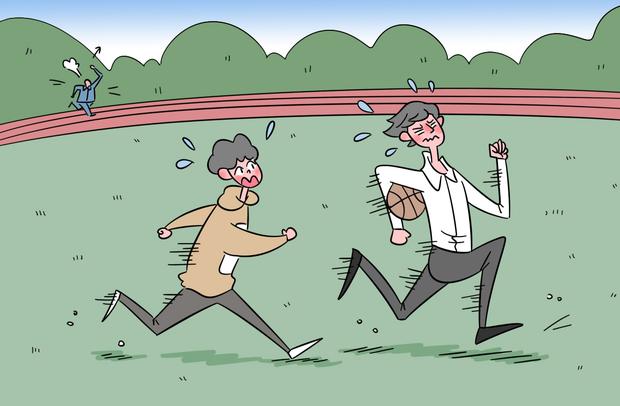英语介词的用法是什么 有哪些口诀
2019-04-08 09:00:39文/丁雪竹介词是一种虚词,用来表示名词或相当于名词的其他词语与句中其他词的关系,不能单独使用。介词可以与名词或相当于名词的其他词构成介词短语。

英语介词的用法有哪些
表示方位的介词:in, to, on
1. in 表示在某地范围之内。
Shanghai is/lies in the east of China. 上海在中国的东部。
2. to 表示在某地范围之外。
Japan is/lies to the east of China. 日本位于中国的东面。
3. on 表示与某地相邻或接壤。
Mongolia is/lies on the north of China. 蒙古国位于中国北边。
表示计量的介词:at, for, by
1. at 表示“以……速度”“以……价格”。
It flies at about 900 kilometers an hour. 它以每小时900公里的速度飞行。
I sold my car at a high price. 我以高价出售了我的汽车。
2. for 表示“用……交换,以……为代价”。
He sold his car for 500 dollars. 他以五百元把车卖了。
注意:at表示单价(price) ,for表示总钱数。
3. by 表示“以……计”,后跟度量单位。
They paid him by the month. 他们按月给他计酬。
Here eggs are sold by weight. 在这里鸡蛋是按重量卖的。
表示材料的介词:of, from, in
1. of 成品仍可看出原料。
This box is made of paper. 这个盒子是纸做的。
2. from 成品已看不出原料。
Wine is made from grapes. 葡萄酒是葡萄酿成的。
3. in 表示用某种材料或语言。
Please fill in the form in pencil first. 请先用铅笔填写这个表格。
They talk in English. 他们用英语交谈。
表示工具或手段的介词:by, with, on
1. by 用某种方式,多用于交通。
I went there by bus. 我坐公共汽车去那儿。
2. with表示“用某种工具”。
He broke the window with a stone. 他用石头把玻璃砸坏了。
注意:with表示用某种工具时,必须用冠词或物主代词。
3. on 表示“以……方式”,多用于固定词组。
They talked on the telephone. 他们通过电话进行交谈。
She learns English on the radio/on TV. 她通过收音机/电视学英语。
表示关于的介词:of, about, on
1. of 仅是提到或谈到过某人或某事。
He spoke of the film the other day.
他前几天提到了这部影片。
2. about 指“关于”某人或某事物的较详细的情况。
Can you tell me something about yourself?
你能告诉我关于你自己的事情吗?
3. on 指“关于”学术性的或严肃的事。
It’s a textbook on the history of china.
它是一本有关中国历史的教科书。
表原因或理由的介词:for, at, from, of, with, by, because of
1. for 表示原因,与sorry, famous, punish, praise, thank, blame连用。
I am sorry for what I said to you.
我后悔不该对你讲那些话。
2. at 指情感变化的原因,意为“因听到或看到而……”。
He was surprised at the news. 听到这消息他大吃一惊。
3. from 指“外在的原因”,如受伤、车祸等。
He died from the wound. 他因受伤而致死。
4. of 指“内在的原因”,如病、饿等。
The old man died of hunger. 老人死于饥饿。
5. with 指生理上或情感上的由外界到内心的原因。
Hearing the news, he jumped with joy.
他们听到这个消息,欣喜若狂。
He was shaking with anger. 他气得浑身发抖。
6. by 表示外部的,尤其是暴力的或无意中造成某种结果的原因。
Her body was bent by age. 他因年老背弯了。
She took your umbrella by mistake.
我因弄错拿了你的雨伞。
7. because of 表示引起结果的直接原因。
He retired last month because of illness/because he ill.
8. owing to 多表示引起某不良后果的原因。
Owing to the rain they could not come. 由于下雨他们没来。
9. thanks to 表示引起某种幸运结果的原因,常译为“幸亏……,多亏……”。
Thanks to John, we won the game.
多亏约翰,我们才赢了这场比赛。
10. out of 表示动机的起因,常译为“出于……”。
He asked the question out of curiosity.
他出于好奇才问了那个问题。
11. through 多表示因局部而影响全局的原因。
The war was lost through bad organization.
战争因组织不周而失败了。
英语介词有哪些
表示时间的介词称为时间介词.表示时间的介词有:at, on, in, before, after等.
一、at, on和in
① at 表示:(在(某时刻、时间、阶段),在……岁时)
My cousin joined the army at fifteen.
我表哥十五岁参的军.
② on 表示:在(某日),在周末,在……节日
He was born on the 15th of August in 1769.
他出生于1769年8月15日.
③ in 表示:在……事后,在……期间,在……年/月
She went to America in 2000.
她2000年去了美国.
at, on 和in 作时间介词的比较:
① at 表示具体时间点.
② on 后可以跟表日期、星期、节日的词,还可以指具体某一天的早、中、晚.
③ in 泛指一天的早、中、晚,还可以表示一段时间,如:周、年、月、季节等.
二、before和after
① before 表示:在……之前 \x09\x09before eight o’ clock 八点之前
Spring comes before summer.
夏天之前是春天.
② after 表示:表示……之后\x09\x09after lunch 午饭之后
Come to my office after school.
放学后请来我办公室.
表示做某事的方法、手段的介词有by, with, in, at, on.
一、by
by表示:用,以,靠,通过……方式.by表示手段时后接动作或制作方式.“by + 交通工具”表示交通方式.
by bike 骑车\x09by bus 坐公车\x09by taxi 搭出租
by train 坐火车\x09by ship 乘船\x09by air 坐飞机
Linda usually goes to work by subway.
琳达通常做地铁上班.
She makes a living by teaching.
她考教书谋生.
二、with
with 表示:用,以.with表示手段时,后接工具、材料或具体内容.
write with a pen 用钢笔写
eat with knife and fork 用刀叉吃
see with one’s eyes 用眼睛看
I killed the fly with a swatter.
我用苍蝇拍打死那只苍蝇.
She cut the cake with a knife.
她用刀切开了蛋糕.
三、in
in 表示:用,以.in表示用某种方式,如:颜色、笔墨、语言、声音、服饰等.
speak in English 用英语说
talk in a high voice 高声说话
I wrote a letter in ink.
我用钢笔写了一封信.
Try to express yourself in English.
试着用英语表达一下.
表示空间的介词有:at, in, on, over, above, under, below 等表示静态位置的介词和from, to, up, down, through, across 等表示动态方向的介词.
一、at, on 和 in
① at 表示:(地点、位置)在……
② on 表示:(位置)在……上面
③ in 表示:(地点、位置或空间)在……里,在……中,在……上
Her fans have arrived at the airport.
她的影迷已经到达了机场.
Look at the picture at the top of the page.
请看以下这一项上面的图片.
Is my pen on the desk or in the desk?
我的钢笔是在桌子上还是在抽屉里呢?
Some kids are playing in the yard and others are playing in the room.
有些孩子在院子里玩,其他则在房间里玩.
at,on 和 in 作空间介词的比较
① at用于表示一个较小的场合,这个地点被当作一个点来看待.
② on 表示在某一平面或线上,强调与某物体有接触.
③ in 表示在较大的地方,在某立体空间或平面范围之内.
二、about 和 around
① over 二者都表示:在……周围/各处,围绕.但
② above about强调无方向.
We walked about in the town.
我们在城里到处游逛.
Dudu is running around the fence.
嘟嘟在绕着篱笆跑.
Let’s plant trees around the house.
让我们在房子周围栽上树.
三、over 和 above
① under 表示:在……正上方,越过
② above 表示:在……上方
I saw a wood bridge over the river.
我看见河上有座木桥.
Look! Some birds are flying above the clouds.
看!一些鸟儿在云朵上飞翔.
over和above作空间介词的比较
① over强调在某人或某物的正上方,而且两物体表面没有接触.
② above 强调位置上某物体的上方,并不一定是正上方,而且两物体表面也没有接触.
四、under 和 below
① under 表示:在……的正下方
② below 表示:在……下方
Please read the words below the picture.
请读图片下面的文字.
Look! A big mouse hides under the armchair.
看!一只大老鼠躲在扶手椅下面.
under 和 below 作空间介词的比较
① under 强调在某物的下方,完全覆盖两物体表面可以接触也可以不接触.
② below 强调位置低于某参照物,但并不一定是正下方.
五、between 和 among
① between 表示:(位置、时间、数量等)在……之间(两者之间)
② among 表示:在……中间(三者或三者以上之间)
I often fly between Beijing and Shanghai.
我经常在北京和上海之间飞来飞去.
Come here between eight and nine o’ clock.
请把点到九点之间过来.
Susan is among the crowd.
苏珊是人群当中.
六、into 和 out of
① into 表示:进来
② out of 表示:出去
Get out of the room.
从房间里出去!
Bob walked into the room.
鲍勃走进房间.
He is working in the office.
她在办公室里工作.
七、behind 和 in front of
① behind 表示:在……后面
② in front of 表示:在……前面
There is a fountain in the front of the park.
公园的前面有一个喷泉.
Susan sits in front of me and Dudu sits behind me.
苏珊坐在我前面,嘟嘟坐在我后面.
八、up 和 down
① up 表示:往上,向……顶上
② down 表示:往下,沿着……往下
The monkey is climbing up the tree.
猴子正在往树上爬.
Tears ran down her face.
眼泪从她的脸上流了下来.
九、across 和 through
① across 表示:穿过,跨过
② through表示:穿过,通过
There is a bridge across the river there.
那儿有座桥横跨在河上.
A train is running through the tunnel.
一列火车正从隧道中穿过.
十、by 和 near
① by 表示:在……旁边
② near 表示:在……附近
Come over here and stand by me.
过来站在我旁边吧.
We are planning to camp by the lake.
我们打算到湖边露营.
There are some big apple trees near the house.
房子附近有一些大苹果树.
The new hospital is near our school.
新医院里我们学校不远.
十一、其他空间介词
① along 表示:沿着,顺着
② to 表示:到……,去……,向……
Let’s walk along the street.
让我们沿着街散散步.
We drove along the freeway.
我们驱车沿着高数公路行驶.
The child pointed to the polar star.
那孩子指着北极星.
I’m going to the bakery.
我想要去那家糕饼店.
*第一个to表示“指”的方向、目标.
第二个to表示到达的目的地.
除了按上面介绍表示时间关系、空间关系、方式、手段等的介词外,还有一些重要的介词:
一、of 的用法
① of 表示:……的(表示所属、所有关系)
a cover of this book
这本书的封皮
a friend of my parents
我父母的一个朋友
② of 表示:……之中的(表示部分)
some boys of the team
小组里的几个男生
the end of the story
故事的结尾
Two students of our class joined in the match.
我们班里的两个同学参加了这场比赛.
All of us approved his plan.
我们全都赞成他的计划.
③ of 表示:……份/量的,……的种类的(表示量、种类)
a drop of water
一滴水
a pair of shoes
一双鞋
I want two cups of coffee.
我要两杯咖啡.
二、with 的用法
① with 表示:具有,有……的,随身带着
It is a dog with black spots.
它是一只长着黑色斑点的狗.
Take an umbrella with you.
带把雨伞吧!
② with表示:和……一起,同……一起,偕同
I went to Disneyland with my mother.
我和妈妈一起去了迪斯尼乐园.
Jane likes to play with Mimi.
简喜欢和玩耍.
③ with 表示:随着……
The wine improves with age.
这种酒越陈越香.
I get up with the sun every day.
我每天日出就起床.
 英语介词的用法口诀
英语介词的用法口诀英语介词的用法口诀:早、午、晚要用in;at黎明、...
2019-11-23 英语介词的用法口诀有哪些
英语介词的用法口诀有哪些介词的用法一直都是英语语法中一个非常重要的部分。介...
2019-10-11 英语介词有哪些 用法是什么
英语介词有哪些 用法是什么介词一般用于名词或者代词前面,表示该词与句中其他成...
2019-04-08 英语介词的用法 最常用的介词有哪些
英语介词的用法 最常用的介词有哪些介词一般用于名词或者代词前面,表示该词与句中其他成...
2019-02-12 英语介词有哪些
英语介词有哪些介词又称为前置词,表示它后面的名词或代词与句子其他...
2019-01-31 专科工资高的十大专业 哪些专业有前景
专科工资高的十大专业 哪些专业有前景专科工资高的十大专业有哪些,什么专业有前景,小编整...
2021-03-26 美术生大学四年花费多少 贵吗
美术生大学四年花费多少 贵吗美术生大学四年花费多少,贵不贵,小编整理了相关信息...
2021-03-26 高中议论文作文素材摘抄2021
高中议论文作文素材摘抄2021作文教学是语文教学的一个重要模块,而作文素材的积累...
2021-03-26 学美发的最佳年龄 多大学合适
学美发的最佳年龄 多大学合适学美发的最佳年龄,多大学合适,小编整理了相关信息,...
2021-03-26 男性冷门高薪职业有哪些 什么职业挣钱
男性冷门高薪职业有哪些 什么职业挣钱男性冷门高薪职业有哪些,什么职业挣钱,小编整理了相...
2021-03-26 高考英语如何快速提分
高考英语如何快速提分学习任何一门语言,首先要让认识这门语言,英文作为世...
2021-03-26 掌门一对一的价格表 收费情况是什么
掌门一对一的价格表 收费情况是什么掌门一对一高级教师:250-350元/小时,仅供小...
2021-03-26 高雅有意境的四字成语
高雅有意境的四字成语想起一个,降龙十八掌,其实就是易经十八个卦象,其实...
2021-03-26 学大一对一收费标准2021 有哪些优势
学大一对一收费标准2021 有哪些优势学大一对一收费标准小编已经为大家找来了,仅供大家参...
2021-03-26 单招面试自我介绍范文 有什么技巧
单招面试自我介绍范文 有什么技巧单招面试自我介绍范文怎么写,面试技巧有哪些,小编整...
2021-03-26
点击查看 高中英语 更多内容




